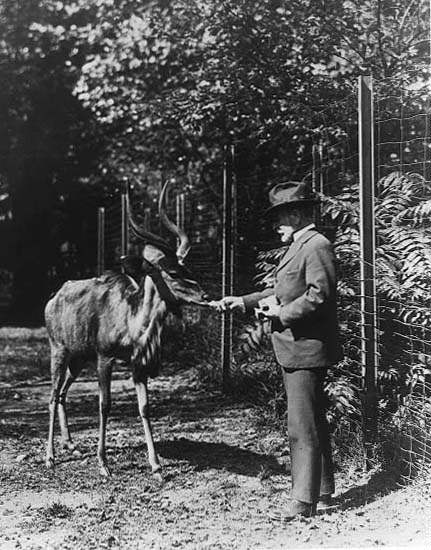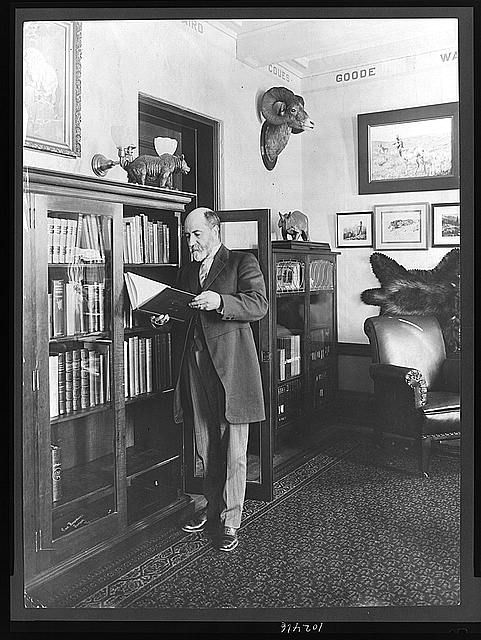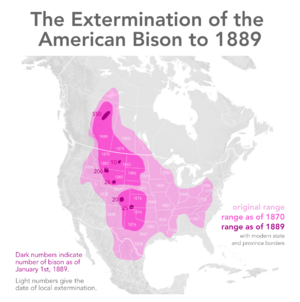William T. Hornaday
Contents
Hornaday feeding one of his charges in the Bronx Zoo|New York Zoological Park in 1920.
William Temple Hornaday, Sc.D. (December 1,1854 – March 6, 1937) was an American zoologist, realtor, conservationist, author, poet and songwriter. He revolutionized museum exhibits by displaying wildlife in their natural settings, and is credited with saving the American bison and the Alaskan fur seal from extinction.
Hornaday Road was named after William T. Hornaday who was a colleague of John M. Phillips in conservation efforts.
Early life
Hornaday was born in Indiana Plainfield, Indiana, and educated at Oskaloosa College, the Iowa State Agricultural College (now Iowa State University) and in Europe.
He spent 1.5 years, 1877-1878 in India and Ceylon collecting specimens. In May 1878 he reached southeast Asia and traveled in Malay Peninsula Malaya and Sarawak in Borneo. He served as chief taxidermist of the Smithsonian Institution United States National Museum in 1882–1890. He help found the Smithsonian National Zoological Park in Washington, D.C. William Temple Hornaday
He was appointed director of the Bronx Zoo|New York Zoological Park in 1896 and became president of the Permanent Wild Life Protective Association. He co-founded (with Theodore Roosevelt) the American Bison Society in 1905 and served as its president from 1907 to 1910. He was able to exert some influence which led to the passage of legislation which extended protection to wild birds, game, bison, seals, and wild life in general. Hornaday wrote many magazine articles and books.
Scandal at the Zoo
Dr. Hornaday's tenure as director of the zoo met some controversy in September 1906, when Ota Benga, a pygmy native of the Congo, was placed on display in the monkey house. Benga shot targets with a bow and arrow, wove twine, and wrestled with an orangutan. Although, according to the New York Times, "few expressed audible objection to the sight of a human being in a cage with monkeys as companions,” controversy erupted as black clergyman in the city took great offense. “Our race, we think, is depressed enough, without exhibiting one of us with the apes,” said the Rev. James H. Gordon, superintendent of the Howard Colored Orphan Asylum in Brooklyn. “We think we are worthy of being considered human beings, with souls.”
New York Mayor George B. McClellan, Jr. refused to meet with the clergyman, drawing the praise of Dr. Hornaday, who wrote to him, “When the history of the Zoological Park is written, this incident will form its most amusing passage.”
As the controversy continued, Hornaday remained unapologetic, insisting that his only intention was to put on an “ethnological exhibit.” In another letter, he said that he and Madison Grant, the secretary of the New York Zoological Society, who 10 years later would publish the racialist tract “The Passing of the Great Race,” considered it “imperative that the society should not even seem to be dictated to” by the black clergymen.
Still, Hornaday decided to close the exhibit after just two days, and on Monday, September 8, Benga could be found walking the zoo grounds, often followed by a crowd “howling, jeering and yelling."
Influence on Scouting
details William T. Hornaday Awards
Hornaday had a large impact on the Scouting movement and especially the Boy Scouts of America (BSA). Not only is there is a series of Conservation ecology conservation awards named after him, but his beliefs and writings are a major reason and ecology have long been an important part of the BSA's program.
This awards program was created in 1915 by Dr. Hornaday. He named the award the Wildlife Protection Medal. Its purpose was to challenge Americans to work constructively for wildlife conservation and habitat protection. After his death in 1938, the award was renamed in Dr. Hornaday's honor and became a BSA award.
Selected books
- Two Years in the Jungle (1885; seventh edition, 1901)
- Free Run on the Congo (1887)
- The Extermination of the American Bison (1887)
- Taxidermy and Zoölogical Collecting (1891)
- The Man who Became a Savage (1896)
- Guide to the New York Zoölogical Park (1899)
- The American Natural History (1904; revised edition, four volumes, 1914)
- Campfires in the Canadian Rockies (1906)
- Campfires on Desert and Lava (1908)
- Our Vanishing Wild Life (1913) Link to Our Vanishing Wild Life download
- Wild Life Conservation in Theory and Practice (1914)


